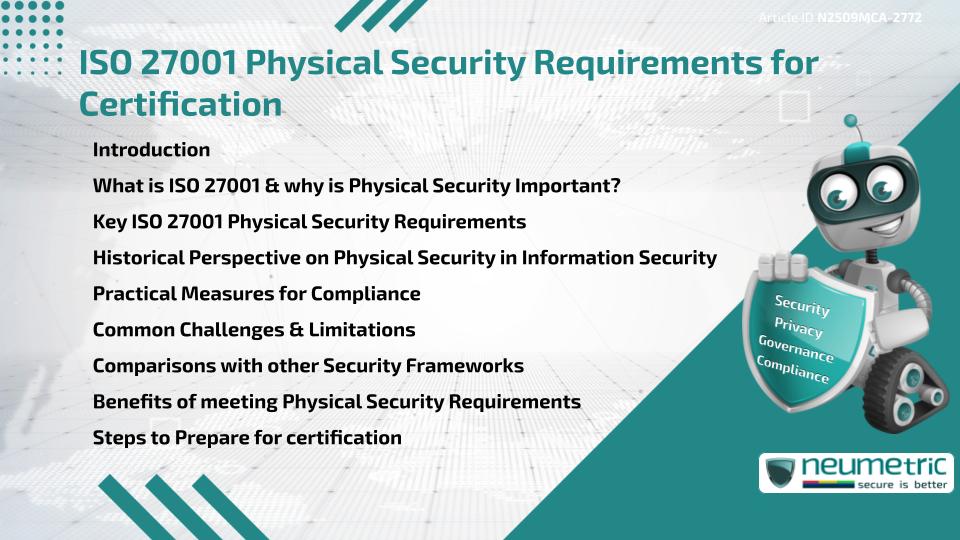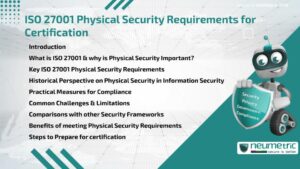Table of Contents
ToggleIntroduction
ISO 27001 Physical Security requirements are an essential part of Certification for Organisations that want to safeguard Information Assets. They focus on controlling access to physical environments, ensuring proper monitoring & preventing unauthorised entry or damage to systems. By addressing Physical Risks alongside digital measures, ISO 27001 helps create a holistic Information Security Framework. This article explores the meaning, importance & practical steps for compliance, along with benefits & challenges faced by Organisations during certification.
What is ISO 27001 & why is Physical Security Important?
ISO 27001 is an international Standard for Information Security Management. It defines how Organisations establish, implement & maintain an Information Security Management System [ISMS]. While most think of Cybersecurity as a digital concept, Physical Security forms a foundational layer. Unauthorised access to data centers, server rooms or even office spaces can result in theft, damage or breaches. Without addressing physical access, an ISMS cannot function effectively.
Key ISO 27001 Physical Security Requirements
The Standard specifies several measures to protect facilities & equipment:
- Controlled access to secure areas through Identification, Badges or Biometric systems.
- Monitoring systems such as cameras & alarms to deter intrusions.
- Procedures for managing visitors & contractors.
- Safeguards for equipment against Environmental Threats like fire or flooding.
- Proper disposal & reuse Policies for physical media & devices.
These measures ensure that physical barriers are as strong as digital ones.
Historical Perspective on Physical Security in Information Security
Before the rise of Cyber Threats, security often meant locking file cabinets or installing alarms. As Organisations moved to digital systems, focus shifted to Firewalls & Encryption. However, breaches involving stolen hardware or unauthorised physical access highlighted the need to integrate Physical Security into broader frameworks. ISO 27001 formalised this integration by mandating controls that cover both aspects.
Practical Measures for Compliance
Organisations preparing for Certification can take practical steps, including:
- Performing site Risk Assessments.
- Installing Access Control mechanisms.
- Training Employees on Security Awareness.
- Conducting regular Inspections & Audits.
- Implementing Disaster Recovery & Emergency Procedures.
Compliance involves not only implementing these measures but also documenting Policies & demonstrating consistent enforcement.
Common Challenges & Limitations
While beneficial, compliance with ISO 27001 Physical Security requirements comes with challenges. Costs for surveillance systems, access technologies & secure facility design can be high. In multinational Organisations, consistency across different regions may be difficult. Human error also poses Risks, as Employees may inadvertently bypass or ignore procedures. These limitations require careful planning & strong organisational culture.
Comparisons with other Security Frameworks
Other frameworks such as NIST & SOC 2 also include physical safeguards, though their focus may vary. ISO 27001 emphasises integration of physical & digital controls within an ISMS, whereas SOC 2 focuses more on service provider responsibilities. The distinction lies in ISO 27001’s broader applicability across industries & geographies.
Benefits of meeting Physical Security Requirements
Organisations that comply with ISO 27001 Physical Security requirements gain several benefits:
- Reduced Risk of physical breaches & data loss.
- Stronger Customer confidence & business reputation.
- Easier alignment with Legal & Regulatory expectations.
- Streamlined Audits & Certification readiness.
These benefits make the investment in physical safeguards worthwhile.
Steps to Prepare for certification
To prepare, Organisations should:
- Map existing controls against the standard.
- Identify Gaps in Physical Security practices.
- Develop an implementation Roadmap.
- Train staff & raise awareness.
- Conduct Internal Audits before external Certification Audits.
Careful preparation ensures smoother Certification & long-term Compliance.
Takeaways
- Physical security is as important as digital safeguards in ISO 27001.
- Proper Access Controls & Monitoring reduce Risks of breaches.
- Training & Awareness strengthen compliance efforts.
- Costs & Consistency are common challenges to overcome.
- Meeting requirements boosts Trust, Reputation & Resilience.
FAQ
What are ISO 27001 Physical Security requirements?
They are controls designed to protect physical facilities, equipment & systems from unauthorised access or damage.
Why is Physical Security important in ISO 27001?
Because without securing physical access points, digital protections alone cannot prevent breaches or theft.
Do Small Businesses need to follow Physical Security requirements?
Yes, regardless of size, every organisation must address physical Risks to achieve Certification.
What are examples of physical Security Measures?
Examples include locks, CCTV cameras, Biometric access & Secure Disposal of old equipment.
How can organisations demonstrate Compliance?
By documenting Policies, performing regular Audits & maintaining Evidence of implemented measures.
Are Physical Security requirements costly to implement?
Costs can vary, but measures can be scaled according to organisational needs & Risk profiles.
What happens if an organisation ignores Physical Security?
Ignoring these requirements can lead to Certification failure, Security Breaches or Legal consequences.
Need help for Security, Privacy, Governance & VAPT?
Neumetric provides organisations the necessary help to achieve their Cybersecurity, Compliance, Governance, Privacy, Certifications & Pentesting needs.
Organisations & Businesses, specifically those which provide SaaS & AI Solutions in the Fintech, BFSI & other regulated sectors, usually need a Cybersecurity Partner for meeting & maintaining the ongoing Security & Privacy needs & requirements of their Enterprise Clients & Privacy conscious Customers.
SOC 2, ISO 27001, ISO 42001, NIST, HIPAA, HECVAT, EU GDPR are some of the Frameworks that are served by Fusion – a SaaS, multimodular, multitenant, centralised, automated, Cybersecurity & Compliance Management system.
Neumetric also provides Expert Services for technical security which covers VAPT for Web Applications, APIs, iOS & Android Mobile Apps, Security Testing for AWS & other Cloud Environments & Cloud Infrastructure & other similar scopes.
Reach out to us by Email or filling out the Contact Form…





